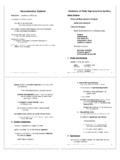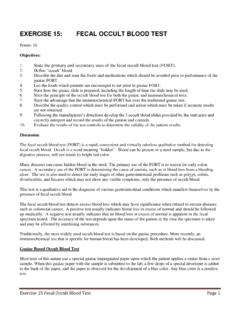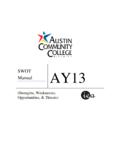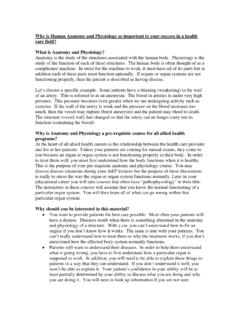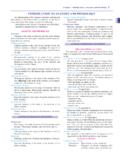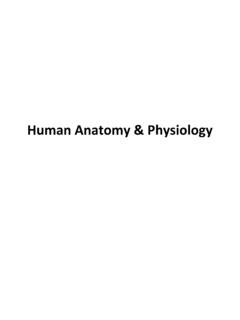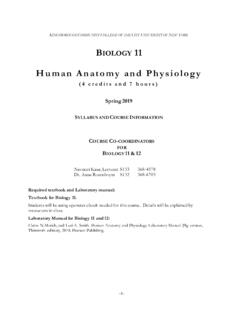Transcription of Skeletal System Skeletal Anatom y
1 human anatomy & Physiology: Skeletal System ; Ziser, Lecture Notes, Systembones, cartilage and ligaments are tightly joined toform a strong, flexible frameworkbone is active tissue:!5-7% bone mass/weekFunctions of Skeletal System :1. Supportstrong and relatively light; 20% body weight2. Movementframework on which muscles actact as levers and pivots3. Protectionbrain, lungs, heart, reproductive system4. Mineral storage (electrolyte balance99% of body s calcium is in bone tissue(1200-1400g vs < in blood, rest in cells)also stores phosphate5. Hemopoiesisblood cell formation6. Detoxificationbone tissue removes heavy metals and other foreign materialsfrom bloodcan later release these materials more slowly for excretionbut this can also have bad consequencesHuman anatomy & Physiology: Skeletal System ; Ziser, Lecture Notes, Anatomyeach individual bone is a separate organ of theskeletal System ~270 bones (organs) of the Skeletal Systemwith age the number decreases as bones fuseby adulthood the number is 206 (typical)even this number varies due to varying numbersof minor bones:sesamoid bones small rounded bones that form withintendons in response to stresseg.)
2 Kneecap (patella), in knuckleswormian bones bones that form within the sutures of skulleach Skeletal organ is composed of many kinds oftissues:bone (=osseous tissue)cartilagefibrous connective tissuesblood (in blood vessels)nervous tissueGeneral Shapes of BonesHuman anatomy & Physiology: Skeletal System ; Ziser, Lecture Notes, can be categorized according to their generalshape:1. long: cylindrical, longer than widerigid levers for muscle actions eg crowbarseg. arms, legs, fingers, toes2. short: length nearly equal widthlimited motion, gliding if anyeg. carpals, tarsals, patella3. flat: thin sheets of bone tissueenclose and protect organsbroad surfaces for muscle attachmentseg. sternum, ribs, most skull bones, scapula, os coxa4. irregular: elaborate shapes different from aboveeg. vertebrae, sphenoid, ethmoidBone Structurebones have outer shell of compact boneusually encloses more loosely organized bone tissue= spongy (=cancellous) boneHuman anatomy & Physiology: Skeletal System ; Ziser, Lecture Notes, general structure of a typical longbone:articular cartilageepiphysisperiosteummedullary cavitydiaphysisendosteumepiphysisepiphys eslarge surface area for muscle attachment and pivotspongy bone with trabeculae;contains red marrow (=hemopoietic tissues)!
3 Produces blood cells in delicate mesh of reticular tissuesin adults red marrow is limited to vertebrae, sternum, ribs, pectoral and pelvic girdles, proximal heads of humerus and femurwith age, red marrow is replaced by yellow marrowarticular cartilageon surface of epiphysesHuman anatomy & Physiology: Skeletal System ; Ziser, Lecture Notes, cushion of hyaline cartilagediaphysisthick compact bone but light; hollow ! medullary cavitymedullary cavityyellow marrow fat (adipose) storage fat at the center of a ham bone in event of severe anemia, yellow marrow cantransform back into red marrow to make blood cellsperiosteumwhite fibrous connective tissue continuous with tendonspenetrates bone welds blood vessels to boneendosteumfibrous CT that lines medullary cavityMicroscopic Structure (Histology)A. bone:connective tissue; contains cells and matrixbone cells = osteocytesmatrix predominates; ~ 1/3rd organic and 2/3rd s inorganicmatrix contains lots of collagen fibersHuman anatomy & Physiology: Skeletal System ; Ziser, Lecture Notes, organized arrangement of matrix andcellslacunae w osteocyte& canaliculilamellaehaversian canalperforating canals (Volkmann canals)interconnect the haversian canalsperiosteum provides life support System forbone cellsblood vessels penetrate bone and connect with those in haversian canalsB.
4 Cartilageresembles bone:large amount of matrixlots of collagen fibersdiffers:firm flexible gel is not calcified (hardened)no haversian canal systemno direct blood supply! nutrients and O2 by diffusionall bone starts out as cartilageHuman anatomy & Physiology: Skeletal System ; Ziser, Lecture Notes, bone the matrix is hardened (= ossified) bycalcification (or mineralization)microscopic structure of cartilage:chondrocytes in lacunaekinds of cartilage:(all similar matrix with lots of collagenfibers; differ in other fibers)1. hyalinemost commoneg. covers articular surfaces of joints, costal cartilageof ribs, rings of tracheae, nose2. fibrousmostly collagen fiberseg. discs between vertebrae, pubic symphysis3. elasticalso has elastic fiberseg. external ear, eustacean tubeHuman anatomy & Physiology: Skeletal System ; Ziser, Lecture Notes, anatomy of Skeletal SystemBone Markings: any bump, hole, ridge, etc on each bone; eg.
5 :Foramen: opening in bone passageway for nerves and bloodvesselsFossa: shallow depression eg a socket into which another bonearticulatesSinus: internal cavity in a boneCondyle: rounded bump that articulates with another boneTuberosity: large rough bump point of attachment for muscleSpine: sharp slender processtwo main subdivisions of Skeletal System :axial : skull, vertebral column, rib cageappendicular: arms and legs and girdlesThe Axial SkeletonA. Skullmost complex part of the skeletonconsists of facial and cranial bonesmost bones are paired, not allHuman anatomy & Physiology: Skeletal System ; Ziser, Lecture Notes, joined at sutures1. Fontanelsossification of skull begins in about 3rd month of fetal developmentnot completed at birth!bones have not yet fusedgaps = fontanelsfrontal (anterior)occipital (posterior)2 sphenoid2 mastoidat this stage skull is covered by tough membrane for protectionnormally, bones grow together and fuse to form solid case around brain3.
6 Skull Cavitiesinside of skull contains several significant cavities:cranial cavity largest (adult 1,300 ml); part of dorsal body cavityorbits eye socketsnasal cavitybuccal cavitymiddle and inner ear cavities4. Paranasal SinusesHuman anatomy & Physiology: Skeletal System ; Ziser, Lecture Notes, 4 of the bones making up the facein life lined with mucous membrane to form sinuseslighten bone, warm and moisten air6 sinuses:frontal -2maxillary -2ethmoid -1sphenoid -1 Examples of Paired Skull Bones:5. Maxillacheek bones, upper teeth cemented to these boneshard palate: palatine process and palatine bonescleft palate ! when bones of palatine process of maxilla bones do not fuse properlynot only cosmetic effectcan lead to serious respiratory and feeding problems inbabies and small childrentoday, fairly easily corrected6. Temporal Boneexternal auditory meatus - opening to ear canalleads to middle ear chamberear ossicles: malleus=hammerincus=anvilstapes=stirrupH uman anatomy & Physiology: Skeletal System ; Ziser, Lecture Notes, Mandible = lower jawlargest, strongest bone of facearticulates at temporal boneExamples of Unpaired Skull Bones:8.
7 Occipital boneforamen magnum-large opening in basethrough which spinal cord passesoccipital condyles-articulation of vertebral column9. sphenoid bone irregular, unpaired boneresembles bat or butterfly; keystone in floor of cranium! anchors many of the bones of craniumcontains sinusessella turcica depression for the pituitary gland10. ethmoid irregular, unpaired bonehoneycomed with sinusescribiform plate perforated with openings whichallow olfactory nerves to passnasal conchae passageways for air; filtering,warming, moisteningcrista galli attachment of meningesHuman anatomy & Physiology: Skeletal System ; Ziser, Lecture Notes, delicate and easily damaged by sharp upward blow to thenosecan drive bone fragments through the cribriform plate into the meninges or brain itselfcan also shear off olfactory nerves! loses of smell11. hyoid bone single U shaped bone in neck just below mandiblesuspended from styloid process of temporal boneonly major bone in body that doesn t directly articulate with other bonesserves as point of attachment for tongue and several other musclesB.
8 Vertebral Columnmain axis of bodyflexible rather than rigidpermits foreward, backward, and some sidewaysmovementdivided into 5 regions:cervicalthoraciclumbarsacralcocc ygealall but last two are similar in structure: human anatomy & Physiology: Skeletal System ; Ziser, Lecture Notes, processvertebral foramentransverse processsuperior and inferior articular processintervertebral foramen between each pairseparated by intervertebral discsCervical (7):have transverse foramena1s t and 2nd are highly modified for movement:atlas holds head upno body or spinous process yes movement of headaxis -- dens (odontoid process) forms pivot no movementThoracic (12):distinguished by facets smooth areas for articulation of ribseach rib articulates at two placesone on body of vertebraeone on transverse processLumbar (5):short and thick spinous processesmodified for attachment of powerful back musclesSacrum (5 fused):triangular bone formed from fused vertebraeHuman anatomy & Physiology: Skeletal System .
9 Ziser, Lecture Notes, joint lots of stressCoccyx (4-5, some fused):tailbonepainful if brokensometimes blocks birth canal, must be brokenC. Ribcagemanubriumsternumbody (=gladiolus)xiphoid processribs: most joined to sternum by costal cartilagestrue ribs (7prs)false ribs (5 prs)include floating ribs (2prs) human anatomy & Physiology: Skeletal System ; Ziser, Lecture Notes, SkeletonA. Upper Extremetiesshoulder (=pectoral girdle)upper and lower armwrist and hand1. Pectoral Girdle:scapula & clavicleonly attached to trunk by 1 joint (between sternum and clavicle)scapula is very moveable acts as almost a 4th segment of limbscapula rides freely and is attached by muscles and tendons to ribs but not by bone to bone jointextensive flat areas of scapula are used as origins for arm muscles and trunk musclesclavicle is the most frequently broken bone in the body, sometimes even during birth2.
10 Upper Arm:Humerus: longest and largest bone of armloosely articulates with scapula by head glenoid cavitylarge processes of scapula, acromium and coracoid!have muscles which help to hold in placeHuman anatomy & Physiology: Skeletal System ; Ziser, Lecture Notes, Forearm:very mobile; adds to flexibility of handconsists of two bones: radius & ulnathey are attached along their length by interosseous membraneulna:main forearm bonefirmly joined to humerous at elbowlarge process = olecranon process, extends behind elbow jointacts as lever for muscles that extends forearmradius:more moveable of twocan revolve around ulna to twist lower arm and hand4. Hand:attached by muscles mainly to radius provides great flexibilitylarge # of rounded bones (carpals) provide flexibilitycarpals allow movement in all directionsmetacarpals also rounded for flexibilityphalanges, not rounded, simple hinges for graspingHuman anatomy & Physiology: Skeletal System ; Ziser, Lecture Notes, Lower Extremetiesnumber and arrangement of bones in the lower limbare similar to those of the upper limbin the lower limb they are adapted for weight bearing and locomotion, not dexteritypelvic girdle (pelvis, 2 coxal bones, sacrum, coccyx)thighlower legfeet1.
